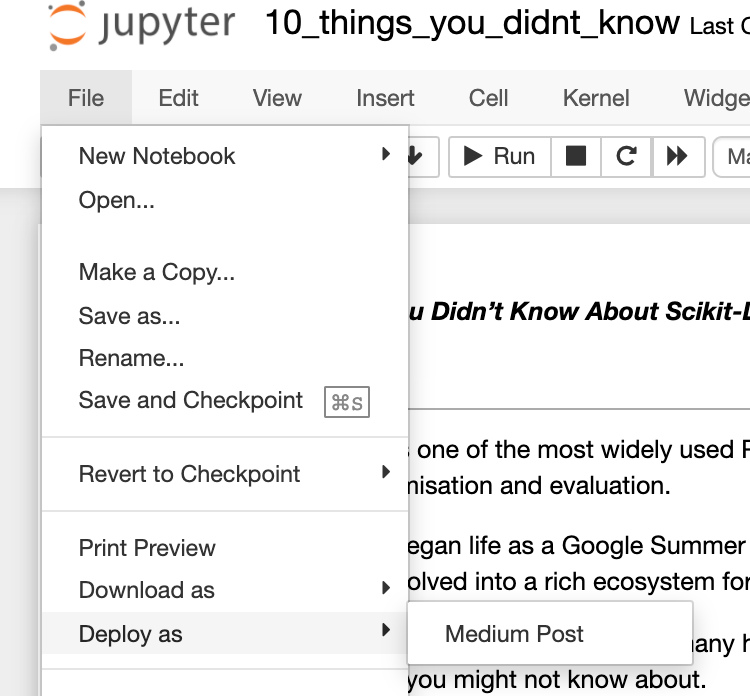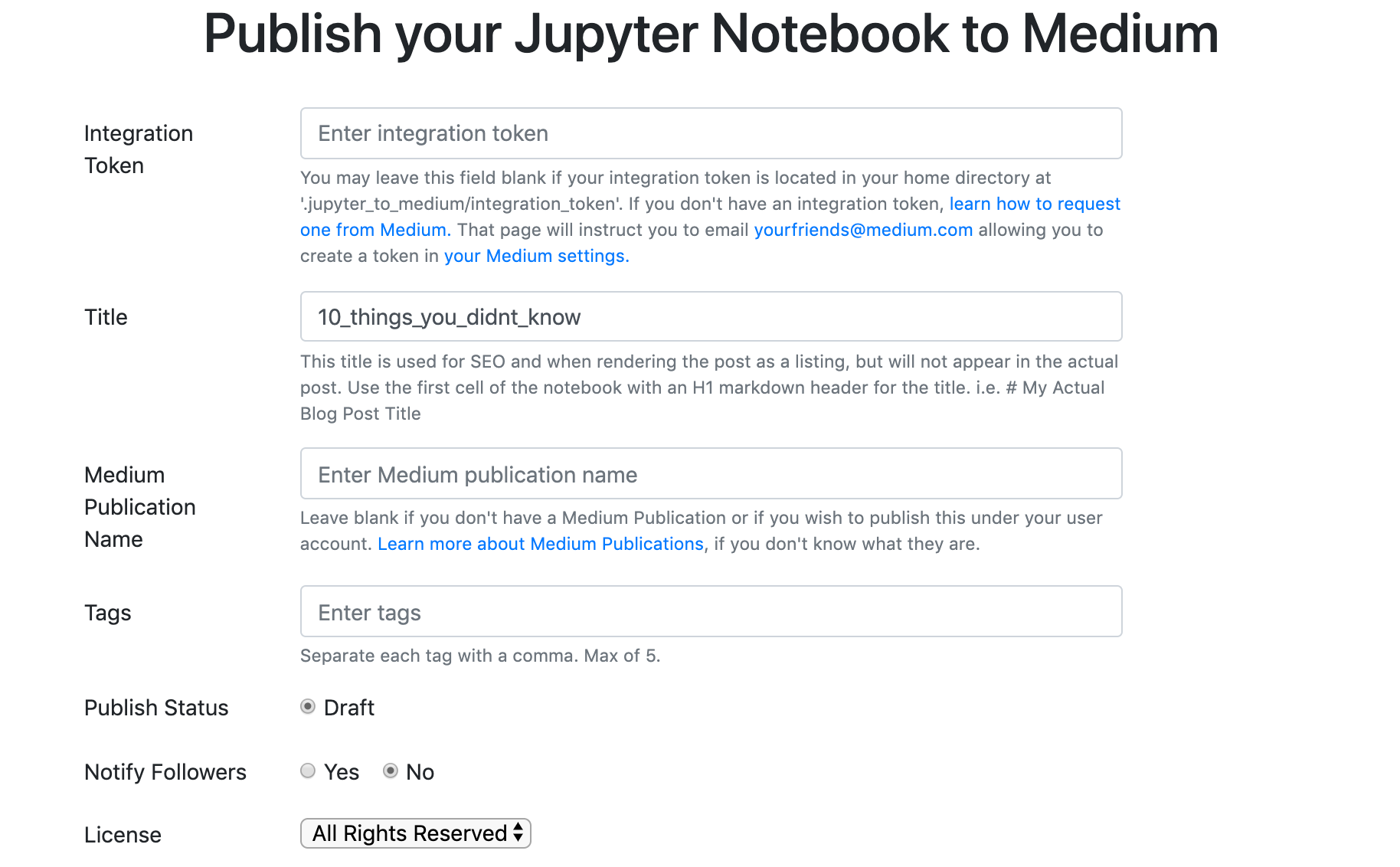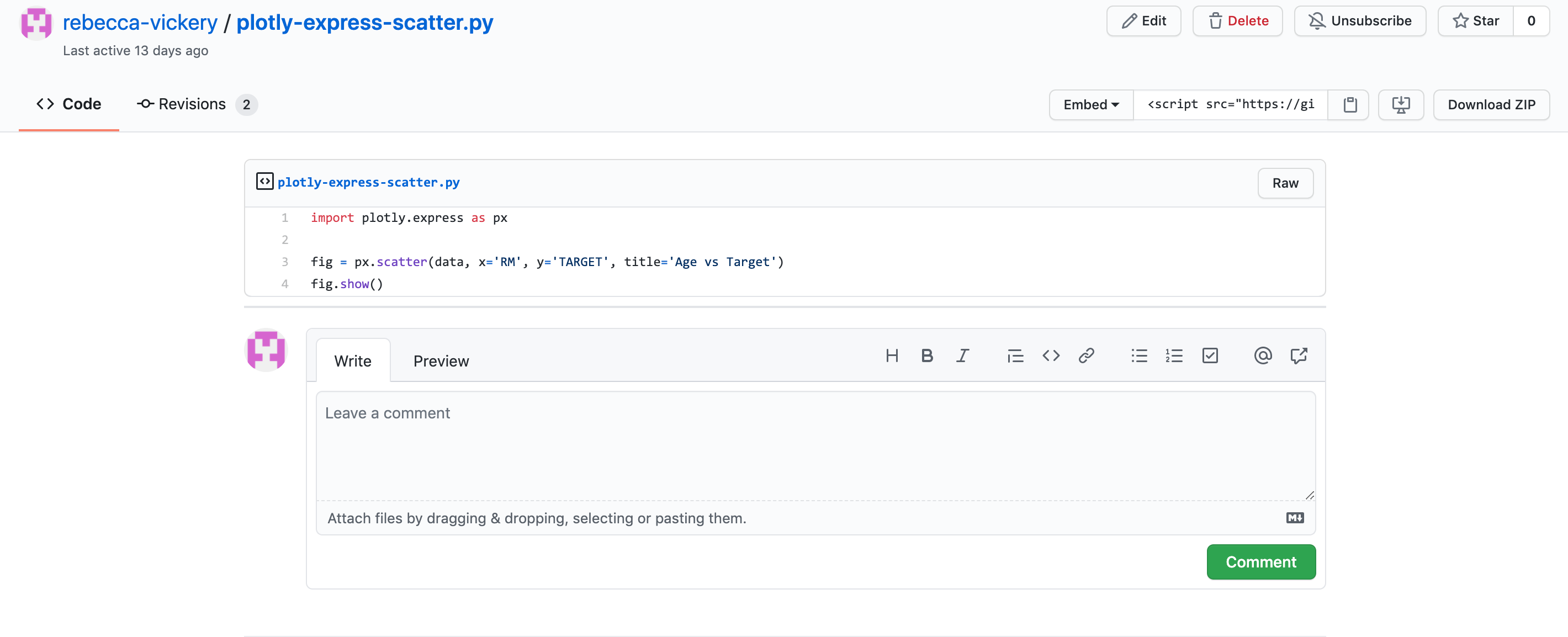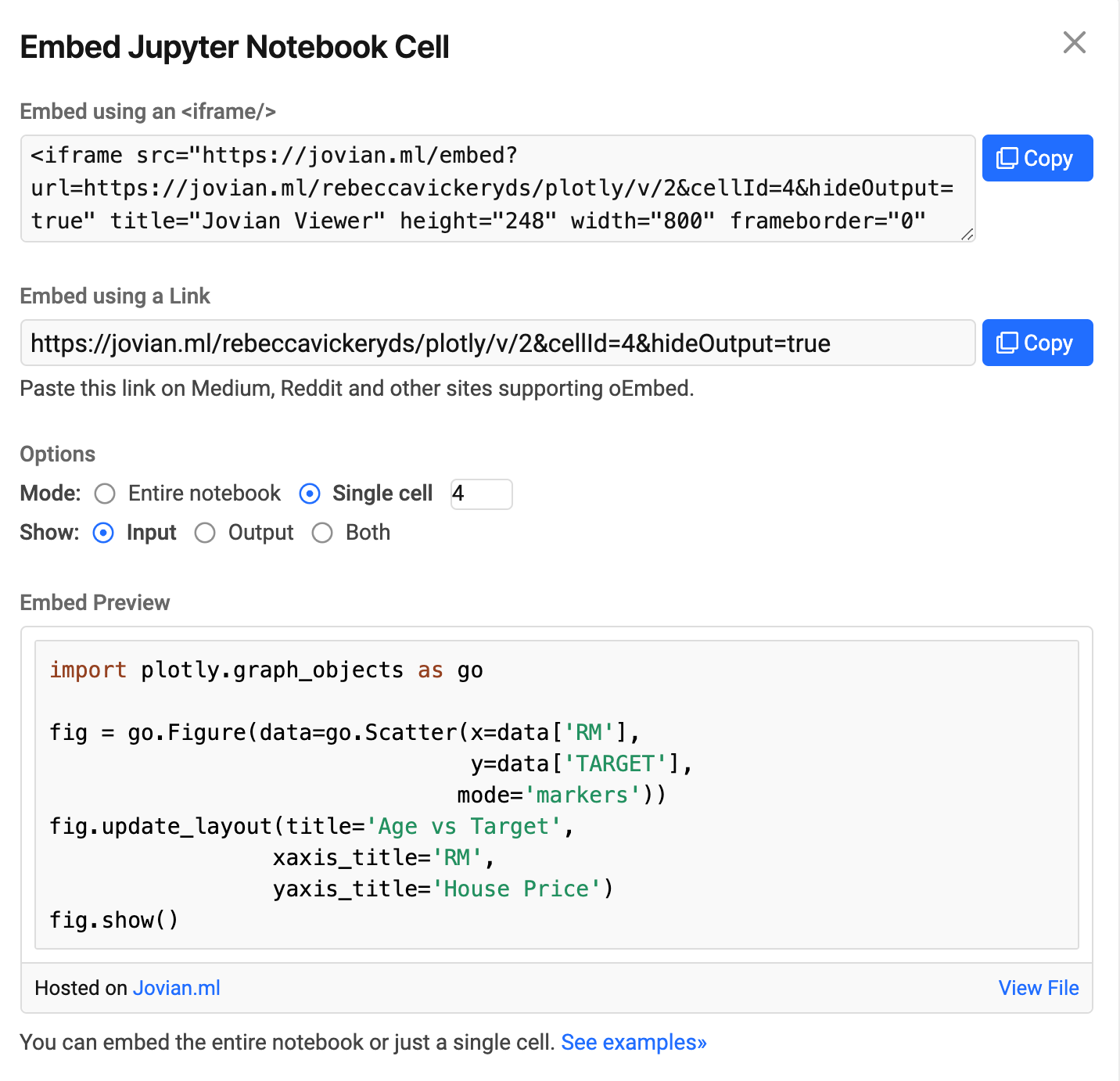写作工具
I’ve been writing about data science on Medium for just over two years. Writing, in particular, technical writing can be time-consuming. Not only do you need to come up with an idea, write well, edit your articles for accuracy and flow, and proofread them. With technical articles you often also need to produce code to illustrate your explanations, ensure that it is accurate and transfer that code from the tool you used to write it, to your Medium post.
我已经写了两年多关于Medium的数据科学的文章。 写作,特别是技术写作,可能很耗时。 您不仅需要提出一个想法,写得好,编辑文章以确保准确性和流程性,并进行校对。 在撰写技术文章时,您通常还需要编写代码来说明您的解释,确保代码准确无误,然后将代码从您用来编写代码的工具转移到Medium帖子中。
I try to publish once or twice a week. When I first started writing I found that the process could be very time consuming, and it was difficult to maintain this schedule around a full-time day job.
我尝试每周发布一次或两次。 当我第一次开始写作时,我发现该过程可能非常耗时,并且很难在一个全日制工作中维持这个时间表。
Over time I have found some tools that have hugely sped up the time it takes for me to create and publish an article. Particularly those containing coded examples. The following tools help me to achieve my goal of publishing one to two articles per week around my other life commitments.
随着时间的流逝,我发现一些工具极大地缩短了我创建和发布文章所需的时间。 特别是那些包含编码示例的代码。 以下工具可帮助我实现每周围绕其他人生承诺发表一到两篇文章的目标。
1. Jupyter至中 (1. Jupyter to Medium)
This tool was only released in May this year by Ted Petrou but it is a game-changer if you write your code in Jupyter Notebooks. With this Python package, you can publish the entire content of your notebook as a blog post directly into your Medium account.
该工具仅在今年5月由Ted Petrou发布,但是如果您在Jupyter Notebooks中编写代码,它将改变游戏规则。 使用此Python软件包,您可以将笔记本的全部内容作为博客文章直接发布到您的Medium帐户中。
To use this tool first you need to pip install it into your project environment.
要首先使用此工具,您需要将其安装到项目环境中。
pip install jupyter_to_mediumYou may need to also install this extension in the environment you are launching your notebook from.
您可能还需要在启动笔记本计算机的环境中安装此扩展程序。
jupyter bundlerextension enable --py jupyter_to_medium._bundler --sys-prefixOnce installed, when you open a Jupyter Notebook and navigate to File >> Deploy as, you will now find an option to deploy as a Medium post.
安装完成后,当您打开Jupyter Notebook并导航至File >> Deploy as时,您现在将找到一个选项作为Medium post进行部署。

When you select this option you will be presented with a form. At the top, it asks for an integration token. If you are a regular writer on Medium you may have access to this in the settings in your Medium account. If you don’t have a token in your settings you will need to contact Medium to request one via this email address yourfriends@medium.com.
选择此选项时,将显示一个表格。 在顶部,它要求一个集成令牌。 如果您是Medium的普通作家,则可以在Medium帐户的设置中访问此内容。 如果您的设置中没有令牌,则需要联系Medium,以通过此电子邮件地址yourfriends@medium.com请求一个。
From my experience, you will get a response quite quickly, typically within 1 to 2 days.
根据我的经验,您通常会在1-2天内很快收到答复。
You can either paste your integration token into this form each time or, to save having to repeatedly access it, you can save the token as a file and directory labelled in the following way.jupyter_to_medium/integration_token.
您可以每次将集成令牌粘贴到此表单中,或者,为了避免重复访问,可以将令牌另存为文件和目录,并以.jupyter_to_medium/integration_token方式标记。

Jupyter to Medium will publish your markdown as text, code as code blocks and images directly to medium as a draft. I have found that you generally only need to perform minimal edits to then get to a publishable blog post.
Jupyter to Medium会将您的降价发布为文本,将代码发布为代码块,并将图像直接发布为草稿。 我发现您通常只需要执行最少的编辑即可访问可发布的博客文章。
2. Github要点 (2. Github Gists)
Github has a tool known as Github Gists that allow you to easily embed code snippets directly into your blog posts. The advantage of using Gists rather than code blocks in your articles is that they preserve the format of the code better, they promote your Github account and it is easier for readers to access your code to try the examples out for themselves.
Github有一个称为Github Gists的工具,可让您轻松地将代码段直接嵌入到博客文章中。 在您的文章中使用Gist而不是代码块的优点是,它们可以更好地保留代码格式,可以提升您的Github帐户,并使读者更轻松地访问您的代码来亲自尝试示例。
You will need a Github account to create a Gist. Once you have one simply navigate to the Gists page at gist.github.com. Creating a Gist is very simple, just give it a name, paste in your code and hit publish. Once published you will see this page. To embed the Gist in your Medium post simply code the URL under ‘Embed’ and paste into your article.
您将需要一个Github帐户来创建一个Gist。 找到一个后,只需导航至gist.github.com的Gist页面即可 。 创建一个Gist非常简单,只需给它命名,粘贴代码并点击publish。 发布后,您将看到此页面。 要将Gist嵌入到您的Medium帖子中,只需将URL编码在“ Embed”下,然后粘贴到您的文章中即可。

The code displays in your Medium post as shown below.
该代码显示在您的中号帖子中,如下所示。
import plotly.express as px
fig = px.scatter(data, x='RM', y='TARGET', title='Age vs Target')
fig.show()3. Jovian.ml (3. Jovian.ml)
Jovian.ml is a tool for hosting Jupyter Notebooks online which is very useful for sharing analyses externally from your local environment. Jovian recently released a feature which makes it possible to embed entire notebooks, snippets of code, cell outputs and markdown directly into your Medium posts.
Jovian.ml是用于在线托管Jupyter Notebook的工具,对于从本地环境外部共享分析非常有用。 Jovian最近发布了一项功能,可以将整个笔记本,代码段,单元格输出和减价直接嵌入到您的Medium帖子中。
To get started with Jovian you need to create an account on jovian.ml. The free tier gives you unlimited public projects which is ideal if you are using it to share via a Medium blog. You then need to pip install into your local environment.
要开始使用Jovian,您需要在jovian.ml上创建一个帐户。 免费套餐为您提供无限的公共项目,如果您正在使用它通过中型博客进行共享,那么这是理想的选择。 然后,您需要将pip安装到本地环境中。
pip install jovianTo upload a local Jupyter Notebook to your online Jovian account simply run the following in your notebook.
要将本地Jupyter笔记本上载到您的在线Jovian帐户,只需在笔记本中运行以下命令即可。
import jovian
jovian.commit()This will prompt you for an API key which you will find in your account.
这将提示您输入在帐户中找到的API密钥。

To embed specific snippets of code in a cell. Navigate to the notebook you have uploaded to your online account and the cell containing the code you want to share. Click on Embed Cell.
将特定的代码片段嵌入单元格中。 导航到您已上传到在线帐户的笔记本以及包含要共享代码的单元格。 单击“ 嵌入单元” 。

This will give you a link you can paste into your Medium post.
这将为您提供一个链接,您可以将其粘贴到“ Medium”帖子中。

This then displays as shown below.
然后显示如下。
4.语法上 (4. Grammarly)
Grammarly is quite a well-known app that checks your content for typos, grammatical errors and even the sentiment of your text. Although an obvious tool for writing it took me a while to start using it, and it made such a difference to the editing time for my articles so I thought it was worth sharing here.
Grammarly是一个非常著名的应用程序,它可以检查您的内容是否有错别字,语法错误,甚至您的文字情感。 尽管一个明显的编写工具花了我一段时间才开始使用它,并且它对文章的编辑时间产生了很大的影响,所以我认为值得在这里分享。
Grammarly can be installed as a browser extension, locally as a desktop app or as a mobile app. To maximise the use of my time I write in many different environments so it is useful to have Grammarly installed locally if I am writing offline, in my browser for when I am directly writing on Medium and on my mobile if I am writing on the go.
语法可以作为浏览器扩展安装,可以在本地作为桌面应用程序或移动应用程序安装。 为了最大限度地利用我的时间,我在许多不同的环境中写作,因此,如果我离线写作,在浏览器中将Grammarly安装在本地是很有用的,这样当我直接在Medium上书写时和在移动设备上书写(如果我在旅途中书写) 。
If you are interested in posts about data science writing on Medium you might find these earlier articles I wrote on the subject useful too.
如果您对在Medium上有关数据科学写作的帖子感兴趣,那么您可能会发现我在该主题上撰写的这些较早的文章也很有用。
Thanks for reading!
谢谢阅读!
翻译自: https://towardsdatascience.com/4-tools-to-speed-up-your-data-science-writing-11d3823cd01b
写作工具























 2万+
2万+

 被折叠的 条评论
为什么被折叠?
被折叠的 条评论
为什么被折叠?








